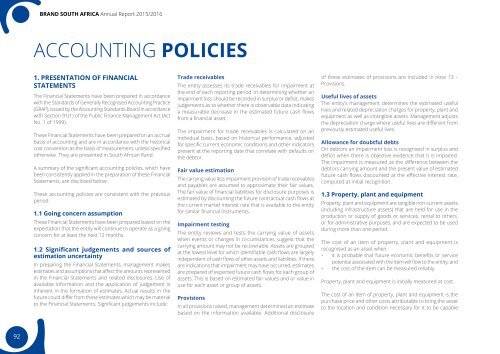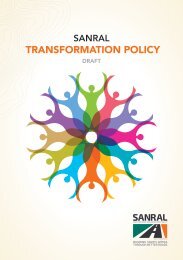Brand-South Africa - Annual report 2015 - 2016
During the past financial year, aligned with its mandate to build pride and patriotism in the Nation Brand, Brand South Africa has worked on initiatives to encourage active citizenship in partnership with its stakeholders in government, business, civil society and identified influential forums to increase the participation of all people, particularly our young people, in building a strong, cohesive Nation Brand. These activities, together with engagements at provincial level on Nation Brand alignment, contribute to social cohesion and a positive Nation Brand. Brand South Africa’s activities took place under the leadership of its new CEO, Amb. Kingsley Makhubela, PhD, who joined the organisation during the year.
During the past financial year, aligned with its mandate to build pride and patriotism in the Nation Brand, Brand South Africa has worked on initiatives to encourage active citizenship in partnership with its stakeholders in government, business, civil society and identified influential forums to increase the participation of all people, particularly our young people, in building a strong, cohesive Nation Brand. These activities, together with engagements at provincial level on Nation Brand alignment, contribute to social cohesion and a positive Nation Brand.
Brand South Africa’s activities took place under the leadership of its new CEO, Amb. Kingsley Makhubela, PhD, who joined the organisation during the year.
You also want an ePaper? Increase the reach of your titles
YUMPU automatically turns print PDFs into web optimized ePapers that Google loves.
and south africa <strong>Annual</strong> Report <strong>2015</strong>/<strong>2016</strong><br />
Accounting Policies<br />
1. Presentation of Financial<br />
Statements<br />
The Financial Statements have been prepared in accordance<br />
with the Standards of Generally Recognised Accounting Practice<br />
(GRAP), issued by the Accounting Standards Board in accordance<br />
with Section 91(1) of the Public Finance Management Act (Act<br />
No. 1 of 1999).<br />
These Financial Statements have been prepared on an accrual<br />
basis of accounting and are in accordance with the historical<br />
cost convention as the basis of measurement, unless specified<br />
otherwise. They are presented in <strong>South</strong> <strong>Africa</strong>n Rand.<br />
A summary of the significant accounting policies, which have<br />
been consistently applied in the preparation of these Financial<br />
Statements, are disclosed below.<br />
These accounting policies are consistent with the previous<br />
period.<br />
1.1 Going concern assumption<br />
These Financial Statements have been prepared based on the<br />
expectation that the entity will continue to operate as a going<br />
concern for at least the next 12 months.<br />
1.2 Significant judgements and sources of<br />
estimation uncertainty<br />
In preparing the Financial Statements, management makes<br />
estimates and assumptions that affect the amounts represented<br />
in the Financial Statements and related disclosures. Use of<br />
available information and the application of judgement is<br />
inherent in the formation of estimates. Actual results in the<br />
future could differ from these estimates which may be material<br />
to the Financial Statements. Significant judgements include:<br />
Trade receivables<br />
The entity assesses its trade receivables for impairment at<br />
the end of each <strong>report</strong>ing period. In determining whether an<br />
impairment loss should be recorded in surplus or deficit, makes<br />
judgements as to whether there is observable data indicating<br />
a measurable decrease in the estimated future cash flows<br />
from a financial asset.<br />
The impairment for trade receivables is calculated on an<br />
individual basis, based on historical performance, adjusted<br />
for specific current economic conditions and other indicators<br />
present at the <strong>report</strong>ing date that correlate with defaults on<br />
the debtor.<br />
Fair value estimation<br />
The carrying value less impairment provision of trade receivables<br />
and payables are assumed to approximate their fair values.<br />
The fair value of financial liabilities for disclosure purposes is<br />
estimated by discounting the future contractual cash flows at<br />
the current market interest rate that is available to the entity<br />
for similar financial instruments.<br />
Impairment testing<br />
The entity reviews and tests the carrying value of assets<br />
when events or changes in circumstances suggest that the<br />
carrying amount may not be recoverable. Assets are grouped<br />
at the lowest level for which identifiable cash flows are largely<br />
independent of cash flows of other assets and liabilities. If there<br />
are indications that impairment may have occurred, estimates<br />
are prepared of expected future cash flows for each group of<br />
assets. This is based on estimated fair values and or value in<br />
use for each asset or group of assets.<br />
Provisions<br />
In all provisions raised, management determined an estimate<br />
based on the information available. Additional disclosure<br />
of these estimates of provisions are included in note 13 –<br />
Provisions.<br />
Useful lives of assets<br />
The entity’s management determines the estimated useful<br />
lives and related depreciation charges for property, plant and<br />
equipment as well as intangible assets. Management adjusts<br />
the depreciation charge where useful lives are different from<br />
previously estimated useful lives.<br />
Allowance for doubtful debts<br />
On debtors an impairment loss is recognised in surplus and<br />
deficit when there is objective evidence that it is impaired.<br />
The impairment is measured as the difference between the<br />
debtors carrying amount and the present value of estimated<br />
future cash flows discounted at the effective interest rate,<br />
computed at initial recognition.<br />
1.3 Property, plant and equipment<br />
Property, plant and equipment are tangible non-current assets<br />
(including infrastructure assets) that are held for use in the<br />
production or supply of goods or services, rental to others,<br />
or for administrative purposes, and are expected to be used<br />
during more than one period.<br />
The cost of an item of property, plant and equipment is<br />
recognised as an asset when:<br />
• it is probable that future economic benefits or service<br />
potential associated with the item will flow to the entity; and<br />
• the cost of the item can be measured reliably.<br />
Property, plant and equipment is initially measured at cost.<br />
The cost of an item of property, plant and equipment is the<br />
purchase price and other costs attributable to bring the asset<br />
to the location and condition necessary for it to be capable<br />
92











